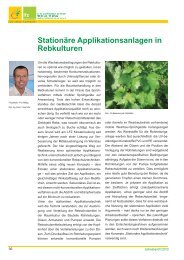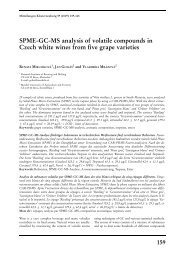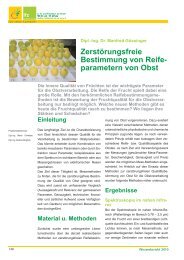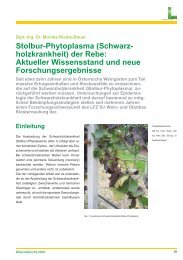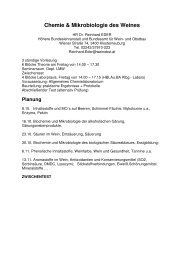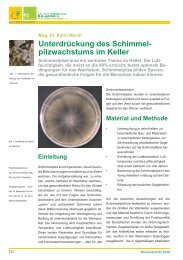Correspondence between gibberellin-sensitivity and pollen tube ...
Correspondence between gibberellin-sensitivity and pollen tube ...
Correspondence between gibberellin-sensitivity and pollen tube ...
You also want an ePaper? Increase the reach of your titles
YUMPU automatically turns print PDFs into web optimized ePapers that Google loves.
Mitteilungen Klosterneuburg 59 (2009): 129-133<br />
BoÈ ll et al.<br />
VER, 1960; WEAVER <strong>and</strong> MCCUNE, 1961).<br />
Early flowering <strong>and</strong> pollination processes are known to<br />
be directed by GA (PHARIS <strong>and</strong> KING, 1985; SINGH et al.,<br />
2002). High GA levels have been reported in <strong>pollen</strong> <strong>and</strong><br />
anthers of several monocotyledonous <strong>and</strong> dicotyledonous<br />
species. These GAs might not only be important<br />
for the pollination process itself, but might also regulate<br />
the subsequent ovule development (IZHAKI et al., 2002;<br />
PHARIS <strong>and</strong> KING, 1985). Thus, differences in endogenous<br />
GA levels of different varieties could be the cause<br />
for a different <strong>sensitivity</strong> towards exogenous GA applications.<br />
To test this hypothesis, endogenous GA levels<br />
in ovaries of two seeded varieties with known differences<br />
in <strong>gibberellin</strong>-<strong>sensitivity</strong>, 'Pinot gris' <strong>and</strong> 'Sylvaner'<br />
(BOÈ LL et al., 2009), were determined by GC-MS analyses<br />
during pre- <strong>and</strong> post-bloom development. In addition,<br />
<strong>pollen</strong> <strong>tube</strong> germination of these varieties together<br />
with nine additional varieties was quantified, <strong>and</strong> their<br />
potential impact on endogenous GA levels during early<br />
berry development is discussed.<br />
Material <strong>and</strong> Methods<br />
Gibberellin extraction <strong>and</strong> GC-MS analysis<br />
In 2006, berries of 'Sylvaner' <strong>and</strong> 'Pinot gris', grown in<br />
Franconian vineyards of the Bavarian State Institute<br />
for Viticulture <strong>and</strong> Horticulture, were collected <strong>and</strong> immediately<br />
frozen for quantitative determination of endogenous<br />
GAs. They were sampled at four developmental<br />
stages (pre-bloom (BBCH 61), post-bloom<br />
(BBCH 68), berries groat-sized (BBCH 73), berries begin<br />
to touch (BBCH 77) from seven to ten clusters to<br />
investigate GA levels of the two varieties over developmental<br />
time. Freeze-dried plant material (0.01 g <strong>and</strong><br />
0.1 g dry weight, respectively) was pulverized under liquid<br />
nitrogen <strong>and</strong> spiked with 17,17-d2-GA st<strong>and</strong>ards<br />
(1 ng each; purchased from Prof. L. M<strong>and</strong>er, Australian<br />
National University, Canberra, Australia). Samples<br />
were extracted, purified, derivatized, <strong>and</strong> analyzed by<br />
combined GC-MS using selected ion monitoring as described<br />
elsewhere (LANGE et al., 2005). Objective of this<br />
analysis were GA 20 , GA 1 <strong>and</strong> GA 8 , three successive<br />
GAs of the 13-hydroxylation <strong>gibberellin</strong> biosynthesis<br />
pathway, with GA 20 being the inactive precursor <strong>and</strong><br />
GA 8 the catabolic successor of the active plant hormone<br />
GA 1 .<br />
Pollen <strong>tube</strong> preparations<br />
In 2006, at full bloom (BBCH 65), ovaries of several<br />
clusters of 'Pinot gris' <strong>and</strong> 'Sylvaner', in 2008, ovaries<br />
of 40 clusters of these varieties <strong>and</strong> nine additional<br />
vine varieties were collected in the field <strong>and</strong> fixed in<br />
FAA solution (50 % ethanol:acetic acid:formalin =<br />
8:1:1 v/v/v). Additionally, for 'Sylvaner' <strong>and</strong> 'Pinot<br />
gris', ovaries from two different vineyards were collected<br />
to examine possible site effects.<br />
In the laboratory 20 ovaries of each variety <strong>and</strong> site<br />
were divided into half longitudinally, rinsed with tap<br />
water <strong>and</strong> stained with aniline blue for 24 hours (2.3<br />
gK 3 PO 4 in 100 ml aqua dest. + 0.1 g aniline blue).<br />
Thereafter, the specimens were rinsed twice with tap<br />
water, mounted on microslides in glycerine <strong>and</strong><br />
slightly squeezed. Pollen <strong>tube</strong>s in the styles of half<br />
ovaries were counted under a fluorescent microscope<br />
with blue light excitation. Data of the 2008 analyses<br />
were allotted to frequency categories <strong>and</strong> a category<br />
mean <strong>and</strong> st<strong>and</strong>ard error of the mean were calculated<br />
for each variety.<br />
Results<br />
GA analyses<br />
The two varieties 'Pinot gris' <strong>and</strong> 'Sylvaner' expressed<br />
striking differences in their endogenous GA levels: endogenous<br />
GA levels were high in 'Pinot gris' before<br />
(BBCH 61) <strong>and</strong> particularly high shortly after fertilization<br />
(BBCH 68 <strong>and</strong> BBCH 73; Fig. 1). Especially the<br />
accumulation of GA 8 , the catabolic product of the plant<br />
hormone GA 1 , is indicating a long lasting GA synthesis<br />
<strong>and</strong> high turnover rates in 'Pinot gris'. In contrast, endogenous<br />
GA levels <strong>and</strong> turnover rates of 'Sylvaner'<br />
were much lower (Fig. 1).<br />
Variety-dependent <strong>pollen</strong> <strong>tube</strong> abundance<br />
Preliminary <strong>pollen</strong> <strong>tube</strong> analyses of 'Sylvaner' <strong>and</strong> 'Pinot<br />
gris' in 2006 had shown striking differences in <strong>pollen</strong><br />
<strong>tube</strong> occurrence, with 'Pinot gris' ovaries displaying<br />
more than three times as many <strong>pollen</strong> <strong>tube</strong>s as ovaries<br />
of 'Sylvaner'. Comparable results were obtained for<br />
these varieties in 2008, without the vineyard site having<br />
any major effect. (Table 1). Altogether, the different<br />
studied varieties displayed a broad range of <strong>pollen</strong> <strong>tube</strong><br />
abundance (Table 1, Fig. 2) that correlates negatively<br />
with their known <strong>sensitivity</strong> towards GA 3 applications<br />
(Table 1).<br />
130



